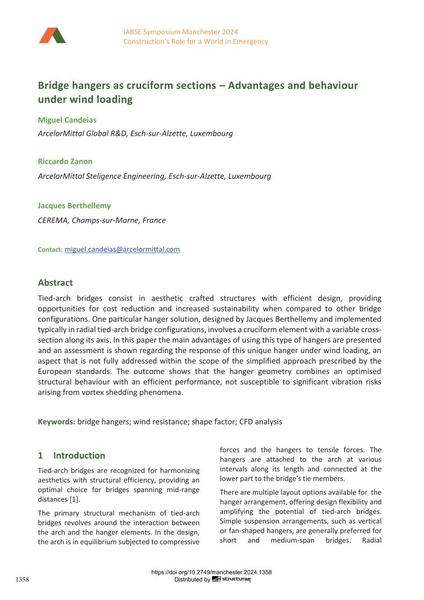Bridge hangers as cruciform sections – Advantages and behaviour under wind loading

|
|
|||||||||||
Bibliografische Angaben
| Autor(en): |
Miguel Candeias
(ArcelorMittal Global R&D, Esch-sur-Alzette, Luxembourg)
Riccardo Zanon (ArcelorMittal Steligence Engineering, Esch-sur-Alzette, Luxembourg) Jacques Berthellemy (CEREMA, Champs-sur-Marne, France) |
||||
|---|---|---|---|---|---|
| Medium: | Tagungsbeitrag | ||||
| Sprache(n): | Englisch | ||||
| Tagung: | IABSE Symposium: Construction’s Role for a World in Emergency, Manchester, United Kingdom, 10-14 April 2024 | ||||
| Veröffentlicht in: | IABSE Symposium Manchester 2024 | ||||
|
|||||
| Seite(n): | 1358-1365 | ||||
| Anzahl der Seiten (im PDF): | 8 | ||||
| DOI: | 10.2749/manchester.2024.1358 | ||||
| Abstrakt: |
Tied-arch bridges consist in aesthetic crafted structures with efficient design, providing opportunities for cost reduction and increased sustainability when compared to other bridge configurations. One particular hanger solution, designed by Jacques Berthellemy and implemented typically in radial tied-arch bridge configurations, involves a cruciform element with a variable cross- section along its axis. In this paper the main advantages of using this type of hangers are presented and an assessment is shown regarding the response of this unique hanger under wind loading, an aspect that is not fully addressed within the scope of the simplified approach prescribed by the European standards. The outcome shows that the hanger geometry combines an optimised structural behaviour with an efficient performance, not susceptible to significant vibration risks arising from vortex shedding phenomena. |
||||
